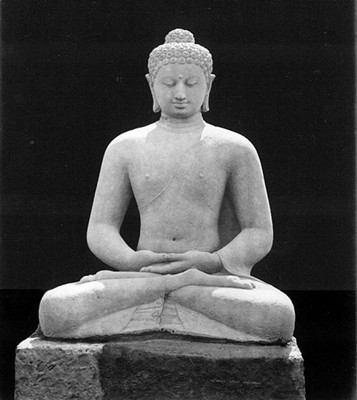From the 1850s onwards it was in Gandhara that vast numbers of Buddhist shrines and sculptures were discovered and investigated, in fact more Buddhist sculpture and architecture comes from Gandhara than from any other part of ancient India.
自十九世纪五十年代以来,考古学家在犍陀罗地区发现了大量的佛教圣地及雕像,数量比在其他古印度地区发现的总量还多。
And here, in the British Museum, we have a Buddha sculpture that perfectly matches the pose of the one in Battersea Park.
大英博物馆中就收藏着这样一尊与巴特西公园中一模一样的佛像。
But this one isn't gold-it's carved from grey schist, a rock that contains fragments of crystal which make the stone glint and gleam in the light.
但此尊却并非真金。它是由灰色页岩打造,这是一种内部含有结晶碎片的岩石,它在光照下光芒闪烁。
The Buddha's hands and face are more-or-less life-size, but the body is smaller, and he sits cross-legged in the lotus position with his hands raised in front of him.
佛像头与手的大小与真人类似,但身体较小。他盘腿呈莲花坐,手置于胸前。
On both shoulders he wears an over-robe, and the folds of the drapery form thick rounded ridges and terraces.
他的双肩皆披袈裟,身上有表现袈裟褶皱厚重深刻的衣纹。
This drapery hides most of his feet, except for a couple of the toes on the upturned right foot, which you can just see.
脚大部分隐藏在衣服之中,只露出脚心朝上的右脚的几个脚趾,你可以在这里看得一清二楚。
He looks serenely into the distance, his eyelids lowered.
他眼帘低垂,安详地注视着远方。
And his hair is gathered up into what seems to be a bun, but which is in fact a symbol of the Buddha's wisdom and enlightened state.
而他的头发整体向上竖起,顶端似有发髻,但其实那是佛陀智慧的象征。
Rising from the top of his shoulders, surrounding his head, is what looks like a large grey dinner-plate-but of course is, in fact, his halo.
而他的双肩往上至后头后的圆盘状物体是他的光环。
This virtually life-sized and lifelike figure must have been a startling sight for any Buddhist 1,800 years ago.
在1800年前,这样的一尊雕像必定会令佛教徒心生恭敬。
Until shortly before then, the Buddha had been represented only by sets of symbols-the tree under which he achieved enlightenment, a pair of footprints, and so on.
在那之前,教徒们一直用一些象征物来代表佛陀,如他开悟时的菩提树、一双脚印等等。
To give him human form was entirely new.
这是他首次拥有人类的相貌。
The move towards representing Buddha as a man is described by the historian Claudine Bautze-Pichron:
在布鲁塞尔自由大学教授印度艺术史的历史学家克劳汀波兹匹克隆解释道。



